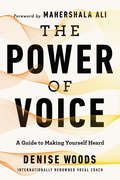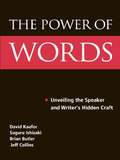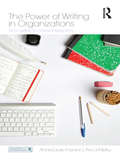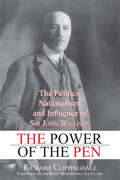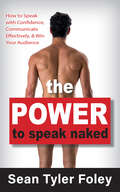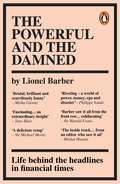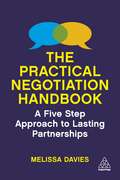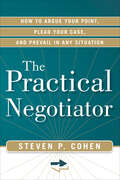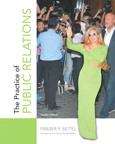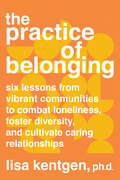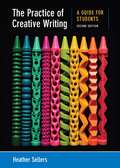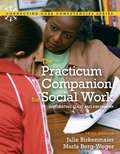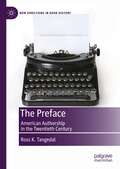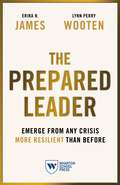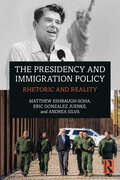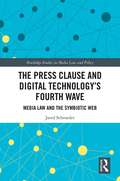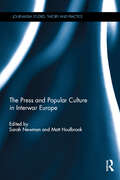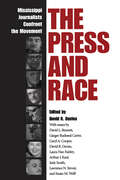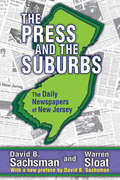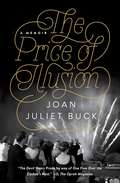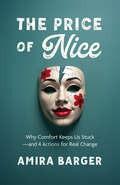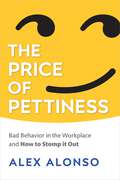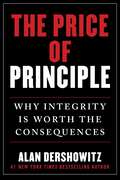- Table View
- List View
The Power of Voice: A Guide to Making Yourself Heard
by Denise WoodsForeword by Academy Award-winner Mahershala AliAn internationally renowned and highly sought-after Hollywood voice coach shares proven practices to help anyone utilize the often-untapped power of their own authentic voice.From a toddler's first words to professional public speaking, from a marriage proposal to asking for a raise, our voice is our most crucial instrument of expression. The world judges us by our voice. And yet there has been no authoritative guide to mastering its full capacity and expressing our true selves in every aspect of life, from relationships and family to work. Until now.As one of the nation’s most sought-after vocal coaches, Denise Woods has worked with everyone from Mahershala Ali, Will Smith, and Idris Elba to Kirsten Dunst and Jessica Chastain. In The Power of Voice, for the first time ever, Woods shares the secrets, tips, lessons, and stories that have helped Hollywood’s biggest stars become confident, effective communicators.Readers will learn how to:Articulate clearlyGain confidence in any situationRelease tension and stressAddress speech issues such as upspeak, vocal fry, and nasalityBecome powerful public speakersFind their truest form of expression With her unmatched ability to teach vocal mastery in real-world terms, Woods offers a much-needed, proven, practical, and invaluable set of tools that will forever change how we communicate and, ultimately, how we see ourselves and affect others.
The Power of Words: Unveiling the Speaker and Writer's Hidden Craft
by David S. Kaufer Jeff Collins Suguru Ishizaki Brian S. ButlerIn 1888, Mark Twain reflected on the writer's special feel for words to his correspondent, George Bainton, noting that "the difference between the almost-right word and the right word is really a large matter." We recognize differences between a politician who is "willful" and one who is "willing" even though the difference does not cross word-stems or parts of speech. We recognize that being "held up" evokes different experiences depending upon whether its direct object is a meeting, a bank, or an example. Although we can notice hundreds of examples in the language where small differences in wording produce large reader effects, the authors of The Power of Words argue that these examples are random glimpses of a hidden systematic knowledge that governs how we, as writers or speakers, learn to shape experience for other human beings.Over the past several years, David Kaufer and his colleagues have developed a software program for analyzing writing called DocuScope. This book illustrates the concepts and rhetorical theory behind the software analysis, examining patterns in writing and showing writers how their writing works in different categories to accomplish varying objectives. Reflecting the range and variety of audience experience that contiguous words of surface English can prime, the authors present a theory of language as an instrument of rhetorically priming audiences and a catalog of English strings to implement the theory. The project creates a comprehensive map of the speaker and writer's implicit knowledge about predisposing audience experience at the point of utterance. The book begins with an explanation of why studying language from the standpoint of priming--not just meaning--is vital to non-question begging theories of close reading and to language education in general. The remaining chapters in Part I detail the steps taken to prepare a catalog study of English strings for their properties as priming instruments. Part II describes in detail the catalog of priming categories, including enough examples to help readers see how individual words and strings of English fit into the catalog. The final part describes how the authors have applied the catalog of English strings as priming tools to conduct textual research.
The Power of Writing in Organizations: From Letters to Online Interactions (Organization and Management Series)
by Anne-Laure Fayard Anca MetiuThis book demonstrates the power of writing in informal and formal organizations in the past and the present. It shows how writing, despite long lasting criticisms that can be traced back to Plato, and in spite of its frequent definition as a mere recording medium is in fact a creative mode of communication that supports the expression of emotions, the developing knowledge, and the building of strong communities among faraway individuals. The first part of the book illustrates how this has been true historically. The focus on writing as a fundamental mode of communication – the other being speech or the oral mode – is still important in our technology-infused world, where writing seems to have been reduced to short cryptic text messages or tweets. Precisely because of their heavy reliance on technology, current practices are in need of a deeper understanding that focus on deep as opposed to surface features and unveil the four essential mechanisms – objectification, reflecting, specifying, and addressing – that give writing its creative powers. In the second part of the book, we use contemporary case studies and interviews to illustrate how shifting our focus from the media to the mode of communication and focusing on the mechanisms of writing allows us to go beyond current debates about the capabilities of various communication media and to understand better today’s communicative practices. This book is an attempt to unveil the powers of writing as well as to highlight the implications for organizations of the potential loss of these powers in today’s world where writing-based distributed collaborations, interpersonal relationships, and online communities are key sources of innovation and support for individuals and organizations.
The Power of the Pen: The Politics, Nationalism, and Influence of Sir John Willison
by Richard Clippingdale Right Honourable Joe ClarkArguably, Sir John Willison had more influence on the evolution of Canada’s emerging nationalism and public policy shifts than any other journalist had in his time or since. Sir John Willison (1856-1927) was the most influential Canadian journalist in the late 19th and early 20th centuries while the country achieved economic growth, intellectual maturation, and world status. With his incisive pen and clear reasoning, Willison utilized Toronto’s Globe and News, his Times of London contributions, his many books and speeches, and his unparalleled connections with key political leaders to establish himself as a major national figure.Uniquely, Willison was at the heart of both the Liberal and Conservative Parties as a devoted supporter and good friend of Sir Wilfrid Laurier; a first employer, early booster, and continual admirer of William Lyon Mackenzie King; and a close ally of Sir Robert Borden. Willison was a major player in the epochal federal political shifts of 1896, 1911, and 1917 and articulated highly influential views on the nature and evolution of Canadian nationalism and public policy.
The Power to Speak Naked: How to Speak with Confidence, Communicate Effectively, & Win Your Audience
by Sean Tyler FoleyThe Power To Speak Naked helps everyone unleash the power to speak the raw naked truth. For those who want to advance their career, increase their wage, improve their social standing, and skyrocket their confidence, The Power To Speak Naked gives them proven strategies to crush their fear of public speaking and empowers them to be able to speak in front of any audience, anywhere, at any time. The Power To Speak Naked features techniques that will make any presentation more dynamic, fire up any team, and give anyone the confidence to overcome their fear of public speaking. Within its pages, Sean Tyler Foley presents easy-to-read tips that make it possible for anyone to deliver a presentation that is engaging, persuasive, and memorable. He also presents proven actionable steps that will help anyone advance in their career and life.
The Powerful and the Damned: Private Diaries in Turbulent Times
by Lionel Barber'Extraordinary' TONY BLAIR'Riveting' - PHILIPPE SANDS'Brutal, brilliant and scurrilously funny' - MISHA GLENNYThe real scoop isn't on the front page'As FT editor, I was a privileged interlocutor to people in power around the world, each offering unique insights into high-level decision-making and political calculation, often in moments of crisis. These diaries offer snapshots of leadership in an age of upheaval...'Lionel Barber was Editor of the Financial Times for the tech boom, the global financial crisis, the rise of China, Brexit, and mainstream media's fight for survival in the age of fake news.In this unparalleled, no-holds-barred diary of life behind the headlines, he reveals the private meetings and exchanges with political leaders on the eve of referendums, the conversations with billionaire bankers facing economic meltdown, exchanges with Silicon Valley tech gurus and pleas from foreign emissaries desperate for inside knowledge, all against the backdrop of a wildly shifting media landscape.The result is a fascinating - and at times scathing - portrait of power in our modern age; who has it, what it takes and what drives the men and women with the world at their feet. Featuring close encounters with Trump, Cameron, Blair, Putin, Merkel and Mohammed Bin Salman and many more, this is a rare portrait of the people who continue to shape our world and who quite literally, make the news.
The Practical Negotiation Handbook: A Five Step Approach to Lasting Partnerships
by Melissa DaviesEffective negotiations lead to sustainable partnerships, help both parties to achieve higher goals than they would alone and allow organizations to avoid the costly price of conflict. This book outlines a simple and powerful method of negotiating, either in person or virtually. The Practical Negotiation Handbook outlines a tried and tested five-step process for negotiating lasting agreements, with best practice case examples, checklists and tools. This thoroughly practical guide brings together over 25 years of the author's experience negotiating in a variety of countries and contexts to give you the confidence to negotiate any kind of contract or agreement, large or small.Using a 'solution-focused' approach which centres around preferred outcomes rather than conflicts, and on questioning and listening to the other party rather than trying to convince or impose and making assumptions, this pragmatic book will help build your profile as an ethical and respected negotiator. From contextual analysis and goal preparation to the importance of communication and building an offer, it cuts through the theory and clearly outlines the skills needed to influence the outcome and implementation of any negotiation.
The Practical Negotiator: How to Argue Your Point, Plead Your Case, and Prevail in Any Situation
by Steven P. Cohen“A well-written practical guide to the art and science of negotiation . . . I found [Cohen’s] advice, offered in a concise Q and A format, to be pure gold.” —Bennett G. Picker, author of Mediation Practice GuideThere’s an inner negotiator in everyone—and The Practical Negotiator helps you find yours. We all need to reach agreement with others in our daily lives, but many people are overly fearful of what they think is a complex process. In this book, prominent consultant Steven Cohen demystifies negotiation, offering common-sense approaches anyone can use no matter what the issue.The Practical Negotiator provides a broad range of real-life negotiating problems faced by people in dozens of countries from every continent (except Antarctica). Each question was submitted by a real person looking for advice. The book’s down-to-earth approach will empower you to:Assess your interests and strengths and find ways to build on themUnderstand the situation and the possibilities at handIncrease your confidence in dealing with othersDevelop and implement simple, practical strategies to further your interests, and more
The Practice Of Public Relations
by Fraser P. SeitelPairing Fraser Seitel's unique, humorous voice with the most up-to-date case studies, interviews, news photos, and other techniques, the Practice of Public Relations is truly an "in-your-face" Public Relations textbook. The 12th edition continues the theme of giving readers the knowledge and skills they need to know to be successful in today's world of public relations --including heavy emphasis on social media and ethics.
The Practice of Belonging: Six Lessons from Vibrant Communities to Combat Loneliness, Foster Diversity, and Cultivate Caring Relationships
by Lisa KentgenAn inspirational guide to the 6 core qualities of healthy communities, for anyone looking to build community as a source of connection and a vehicle for social changeAfter two years meeting with different communities in the US, psychologist Lisa Kentgen identified 6 key traits of vibrant, healthy communities that we can all apply to our own lives and networks:Commitment to careAcceptanceDiversitySkillful conflict resolutionBonding ritualsHospitalityEach chapter focuses on one of these traits, highlighting a particular community as a case study of how it can be put into practice. You&’ll learn about a wide range of successful community models, including a tiny-home village for people who had been chronically houseless in Austin, Texas; a study circle to build connection between Native and non-Native people in a small town in South Dakota; a 500-member community choir in Columbus, Ohio; and a Buddhist center in Barre, Massachusetts committed to bringing greater diversity to the Dharma.Throughout the book, you&’ll reflect: How can we cultivate these traits of vibrant community in our own lives? What would it look like to prioritize caring and acceptance in our interactions with others? How can we create a climate of true inclusivity, one where our differences both challenge and strengthen us? How can we learn to feel more comfortable with tension and acquire the skills to move through conflict toward creative solutions? What would happen if we incorporated meaningful rituals into our communities and made a point of celebrating each other? With intention and practice, we can transform our social relationships and build communities that appreciate difference, encourage authentic expression, and foster an environment of belonging and mutual care. This book will inspire you to make the transformative leap from &“me&” to &“we,&” creating communal, loving spaces in which to connect--and thrive--together.
The Practice of Creative Writing: A Guide for Students Second Edition
by Heather SellersDesigned for all students in the introductory course, The Practice of Creative Writing has a simple message: you can do this, and it’s worthwhile to try. Heather Sellers, who writes in multiple genres herself, has developed an approach that focuses on the habits and strategies that produce good writing in any genre: Images; Energy; Tension; Pattern; Insight; and Revision. She teaches students how to focus, to generate lots of writing, and to get to the good stuff — the powerful imagery and the stories they really want to tell.
The Practicum Companion for Social Work: The Integrating Class and Fieldwork
by Marla Berg-Weger Julie BirkenmaierThe ideal companion for the first field/practicum experience, this text guides students through their placement while reinforcing the linkages between classroom learning, practice behaviors and competencies. It includes detailed information on the field/practicum experience from start to finish.
The Preface: American Authorship in the Twentieth Century (New Directions in Book History)
by Ross K. TangedalBuilding on insights from the fields of textual criticism, bibliography, narratology, authorship studies, and book history, The Preface: American Authorship in the Twentieth Century examines the role that prefaces played in the development of professional authorship in America. Many of the prefaces written by American writers in the twentieth century catalogue the shifting landscape of a more self-consciously professionalized trade, one fraught with tension and compromise, and influenced by evolving reading publics. With analyses of Willa Cather, Ring Lardner, F. Scott Fitzgerald, Ernest Hemingway, Robert Penn Warren, and Toni Morrison, Ross K. Tangedal argues that writers used prefaces as a means of expanding and complicating authority over their work and, ultimately, as a way to write about their careers. Tangedal’s approach offers a new way of examining American writers in the evolving literary marketplace of the twentieth century.
The Prepared Leader: Emerge from Any Crisis More Resilient Than Before
by Lynn Perry Wooten Erika H. JamesThe next crisis might be here now, or it might be around the corner. In The Prepared Leader: Emerge from Any Crisis More Resilient Than Before, two history-making experts in crisis leadership—James, dean of The Wharton School of the University of Pennsylvania, and Wooten, president of Simmons University—forcefully argue that the time to prepare is always.In no other time in recent history have leaders in every industry and on every continent grappled with so many changes that have independently and simultaneously undermined their ability to lead. The Prepared Leader encapsulates more than two decades of the authors’ research to convey how it has positioned them to navigate through the distinct challenges of today and tomorrow. Their insights have implications for every leader in every industry and every worker at every level.In their fast-reading and actionable book, James and Wooten provide tools and frameworks for addressing and learning from crises, and they provide insight into what you need to know to become a Prepared Leader, including:The five phases of crisis management and the skills you need for each phase. They examine how the National Basketball Association and its commissioner, Adam Silver, responded to the COVID-19 pandemic.Making the right decisions under pressure and how to avoid common mistakes. They reveal how Burger King CEO Jose Cil began planning for the aftermath of a crisis right in the middle of one.Building a crisis leadership team and how to lead one that you’ve inherited. They detail how Wonya Lucas, CEO and President of the Crown Media Family Networks, aligned and mobilized an executive team during a time of crisis.James and Wooten argue that—in addition to people, profit, and the planet—prepared leadership should be the fourth “P” in a company’s bottom line. They bring decades of world-renowned research on crisis leadership, diversity and inclusion, management strategy, and positive leadership to the table to help leaders better prepare themselves to lead through crises—and for whatever lies around the corner.
The Presentation Secrets Of Steve Jobs: How to Be Insanely Great in Front of Any Audience
by Carmine GalloNow in paperback--the Wall Street Journal bestseller that reveals the secrets behind Steve Job's legendary presentations, with a new introduction about his legacy. Celebrating the inspiring life and vision of Apple's game-changing CEO, The Presentation Secrets of Steve Jobs has become the essential go-to guide for top-level executives, middle managers, organizational speakers, startup entrepreneurs, and pretty much anyone who needs to engage, persuade, and captivate an audience. This is as close as you'll ever get to having the master presenter himself speak directly in your ear. Communications expert Carmine Gallo has studied and analyzed the very best of Jobs's performances, offering point-by-point examples, tried-and-true techniques, and proven presentation secrets that anyone can master. You'll learn how to take charge of a room, create an inspiring brand story, deliver unforgettable moments--and do it powerfully, effortlessly, and effectively.
The Presidency and Immigration Policy: Rhetoric and Reality
by Matthew Eshbaugh-Soha Eric Gonzalez Juenke Andrea SilvaThis comprehensive analysis of presidential immigration rhetoric quantifies the frequency, tone, and efficacy of public mentions of immigrants and immigration policy by the presidents from Washington through Biden. The book also explores the intersection of the presidential role with that of the other key actors in the immigration policy system—notably the press, the public, and Congress. For students of immigration studies, presidential studies, and political communication, this book also poses the question of which is of the greatest significance to the immigration policy agenda: presidential leadership making immigration a top priority or existing legislative support for comprehensive immigration reform.
The Press Clause and Digital Technology's Fourth Wave: Media Law and the Symbiotic Web (Routledge Studies in Media Law and Policy)
by Jared SchroederDuring the first part of the twenty-first century, bloggers, citizen journalists, social media users, Yelp reviewers, and a myriad of other communicators have found themselves facing defamation, privacy, campaign finance, and other lawsuits as a result of the messages they have communicated. In many ways, these communicators are facing legal questions that are similar to what traditional journalists have faced for centuries regarding their rights to gather and publish information. This book examines how the press clause, a First Amendment freedom with no agreed-upon definition, can be understood in order to help guide the courts and twenty-first-century publishers regarding protecting expression as we move into the fourth wave of networked communication, an era that will be defined by increasingly complex relationships between humans and artificially intelligent communicators. To do so, the book draws upon the discourse theory of communication in democratic society, the legal and foundational history of the press clause, lower-court cases that involve citizen publishers who have claimed protections that have historically been associated with traditional journalism, and established legal and scholarly examinations of artificial intelligence to ultimately construct a framework for how the press clause can be reimagined to protect older and newer generations of publishers.
The Press Effect: Politicians, Journalists, and the Stories that Shape the Political World
by Paul Waldman Kathleen JamiesonHow our news is altered by those who report it.
The Press and Popular Culture in Interwar Europe (ISSN)
by Sarah Newman Matt HoulbrookThis collection shows the importance of a comparative European framework for understanding developments in the popular press and journalism between the wars. This was, it argues, a formative and vital period in the making of the modern press. A great deal of fine scholarship on the development of modern forms of journalism and newspapers in the nineteenth and twentieth centuries has emerged within discrete national histories. Yet in bringing together essays on Britain, France, Germany, Italy and Poland, this book discerns points of convergence and divergence, and the importance of the European context in shaping how news was defined, produced and consumed. Challenging the tendency of histories of the press to foreground processes of ‘Americanisation’ and the displacement of older notions of the ‘fourth estate’ by new forms of human interest journalism, the chapters draw attention to the complex ways in which the popular press continued to be politicized throughout the interwar period. Building on this analysis, the book examines the forms, processes and networks through which newspapers were produced for public consumption. In a period of massive social, political and economic upheaval and conflict, the popular press provided a forum in which Europe’s meanings and nature could be constructed and contested. The interpersonal, material and technological links between newspapers, news corporations and news agencies in different countries served to define the outlines of Europe. Europe was called into being through the circulation of news and the practices and networks of the modern mass press traced in this volume. This publication is highly relevant to scholars of the history of journalism and cultural historians of interwar Britain and Europe.This book was originally published as a special issue of Journalism Studies.
The Press and Race: Mississippi Journalists Confront the Movement
by David R. DaviesFor southern newspapers and southern readers, the social upheaval in the years following Brown v. Board of Education (1954) was, as Time put it in 1956, “the region's biggest running story since slavery.” The southern press struggled with the region's accommodation of the school desegregation ruling and with Black America's demand for civil rights. The nine essays in The Press and Race illuminate the broad array of print journalists' responses to the civil rights movement in Mississippi, a state that was one of the nation's major civil rights battlegrounds. Three of the journalists covered won Pulitzer Prizes for their work and one was the first female editorial writer to earn that coveted prize. The journalists and editors covered are Hodding Carter, Jr. (Greenville Delta Democrat-Times), J. Oliver Emmerich (McComb Enterprise-Journal), Percy Greene (Jackson Advocate), Ira B. Harkey, Jr. (Pascagoula Chronicle), George A. McLean (Tupelo Journal), Bill Minor (New Orleans Times-Picayune), Hazel Brannon Smith (Lexington Adviser), and Jimmy Ward (Jackson Daily News). Their editorial stances run the gamut from moderates such as Minor, Smith, and Carter, Jr., to openly segregationist editors such as Ward and Greene. The Press and Race follows the press from the 1954 Brown v. Board of Education decision to 1965, when Congress passed the Voting Rights Act. Those years saw some of the most notable events of the civil rights movement—the South's resistance to school desegregation throughout the 1950s and 1960s; the Freedom Rides of 1961; James Meredith's admission into the University of Mississippi in 1962; the assassination of Medgar Evers in 1963; and the events of Freedom Summer in 1964. These essays present an in-depth analysis of the editorials, articles, journalistic standards, and work of Mississippi newspaper reporters and editors as they covered this tumultuous era in American history. While a handful of Mississippi journalists openly defended Black people and challenged the state's racial policies, others responded by redoubling their support of Mississippi's segregated society. Still others responded with a moderate defense of Black Americans' legal rights, while at the same time defending the status quo of segregation. The Press and Race reveals the outrage, emotion, and deliberation of the people who would soon be carrying out the nation's command to end segregation. The journalists discussed here were southerners and insiders in a crisis. Their writing made journalism history.
The Press and the Suburbs: The Daily Newspapers of New Jersey
by David B. SachsmanThe changing economic and demographic patterns of the United States have many measurements; few of them, however, are more comprehensive than the new circulation realities of the press. This volume tells the story of the twenty-six daily newspapers of New Jersey from the 1960s to the 1980s and in so doing tells the story of the rise of suburbia and the golden age of suburban journalism. In an intense effort to keep pace with the changing location of their readers and most particularly with the upscale consumers the shift to the suburbs was marked by changes in news coverage, advertising, and promotion.Though people have predicted the decline of newspaper business for more than fifty years, they were proven wrong by the rise of the suburban press and by the survival of most newspapers, urban and suburban alike, through the 1980s and 1990s. But in the twenty-first century, the news and information industry has changed, and the national and international economy has faltered.In his new preface, David Sachsman takes the reader on a tour of what happened to each of the New Jersey daily newspapers since the publication of the original. The twenty-six newspapers studied have dwindled to sixteen, and huge losses in circulation have caused drastic cutbacks and mergers. The decline in New Jersey newspaper readership is part of a national trend. This is an essential book for all American historians, journalists, and communication specialists.
The Price of Illusion: A Memoir
by Joan Juliet BuckFrom Joan Juliet Buck, former editor-in-chief of Vogue Paris and &“one of the most compelling personalities in the world of style&” (New York Times) comes her dazzling, compulsively readable memoir: a fabulous account of four decades spent in the creative heart of London, New York, Los Angeles, and Paris—&“If you loved The Devil Wears Prada, you&’ll adore The Price of Illusion&” (Elle).In a book as rich and dramatic as the life she&’s led, Joan Juliet Buck takes us into the splendid illusions of film, fashion, and fame to reveal, in stunning, sensual prose, the truth behind the artifice. The only child of a volatile movie producer betrayed by his dreams, she became a magazine journalist at nineteen to reflect and record the high life she&’d been brought up in, a choice that led her into a hall of mirrors where she was both magician and dupe. After a career writing for Vogue and Vanity Fair, she was named the first American woman to edit Vogue Paris. The vivid adventures of this thoughtful, incisive writer at the hub of dreams across two continents over fifty years are hilarious and heartbreaking. Including a spectacular cast of carefully observed legends, monsters, and stars (just look at the index!), this is the moving account of a remarkable woman&’s rocky passage through glamour and passion, filial duty and family madness, in search of her true self.
The Price of Nice: Why Comfort Keeps Us Stuck—and 4 Actions for Real Change
by Amira Barger“What’s wrong with nice?!” A simple and powerful question. It demands we interrogate the unspoken rules that shape our lives, often without our realizing it.“It costs nothing to be nice!” What a travesty of logic. Niceness is not free—it comes at a steep price. It’s a velvet glove over an iron fist, stifling dissent, prioritizing comfort over progress, and conditioning us to accept the status quo. Niceness is one of the most insidious social constructs, keeping us compliant, silent, and complicit in inequity. If we don’t question it, we stay exactly where power wants us—agreeable, easy to manage, and stuck.The Price of Nice is about breaking free. Amira Barger deconstructs our cultural obsession with niceness, exposes its hidden costs, and offers a practical framework for real change. With sharp analysis and personal insight, she helps readers disrupt the narratives that keep them stuck and reclaim their power.Guided by four dimensions rooted in social psychology—think, feel, do, revisit—this book offers immediate, adaptable practices for creating change. Because breaking free isn’t only what you know—it’s what you do next.If you're tired of “good enough,” this book will challenge you, change you, and call you to more.
The Price of Pettiness: Bad Behavior in the Workplace and How to Stomp It Out
by Alexander AlonsoBeyond the usual everyday annoyances and exasperations we all experience in the workplace, pettiness limits careers and opportunities on a broad scale and sometimes crosses the line into criminal behavior.Based on recent research conducted by SHRM, this groundbreaking book examines the seemingly limitless depths of workplace pettiness - as well as the remarkable heights of creativity it seems to inspire in people - and delivers proven tools for anyone to spot pettiness and deal with it directly. In addition to revealing the root cause of pettiness and what can be done to eliminate it, Dr. Alonso also offers insights into the personal and organizational costs associated with petty behavior and shows how HR can be its most fierce adversary. But perhaps best of all, he shares some of the most incredible true stories about petty behavior in the workplace you'll ever read!Filled with unforgettable examples, this is essential reading for anyone ready to build a healthier, more productive workplace.
The Price of Principle: Why Integrity Is Worth the Consequences
by Alan DershowitzIn his fiftieth book, The Price of Principle: Why Integrity Is Worth the Consequences, Alan Dershowitz—#1 New York Times bestselling author and one of America&’s most influential legal scholars—explores the implications of the increasing tendency in politics, academia, media, and even the courts of law to punish principle and reward partisan hypocrisy. Alan Dershowitz has been called &“one of the most prominent and consistent defenders of civil liberties in America&” by Politico, and &“the nation&’s most peripatetic civil liberties lawyer and one of its most distinguished defenders of individual rights&” by Newsweek. Yet, he has come under intense criticism for living by his principles and applying his famed &“shoe on the other foot test.&” Price of Principle is about efforts to cancel Alan Dershowitz and his career because he has insisted on sticking to his principles instead of choosing sides in the current culture and political war dividing our country. He explains that principled people are actively punished for not being sufficiently partisan. Principle has become the vice and partisanship the virtue in an age when partisan ends justify unprincipled means, such as denial of due process and free speech in the interest of achieving partisan or ideological goals. Throughout his narrative, Dershowitz focuses on three sets of principles that have guided his life: 1) freedom of expression and conscience; 2) due process, fundamental fairness, and the adversary system of seeking justice; and 3) basic equality and meritocracy. He documents the attacks on him and others like him for being &“guilty&” of refusing to compromise important principles to promote partisanship. He names names and points fingers of accusation at those who have led us down this dangerous road. In the end, Price of Principle represents an icon in the defense of free speech and due process reckoning with the challenges of unprincipled attacks—a new brand of McCarthyism—and insisting that we ask hard questions about our own moral principles.
